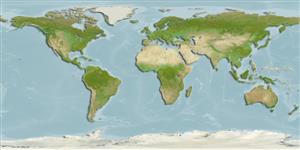>
Gobiiformes (Gobies) >
Gobiidae (Gobies) > Gobiinae
Etymology: Trimma: Greek, trimma, -atos = something crushed (Ref. 45335); burridgeae: Named for Mary Elizabeth Burridge (for her extensive work in the revisions of Priolepis, her ongoing work on barcoding Trimmaspp., her field collection in the Philippines and Vietnam, and her extensive contributions to the maintenance of the fish and frozen tissue collections at the Royal Ontario Museum)..
Environment: milieu / climate zone / depth range / distribution range
Ekologi
laut; kisaran kedalaman 4 - 50 m (Ref. 109919), usually 20 - 30 m (Ref. 109919). Tropical
Western Pacific: Palau.
Size / Weight / umur
Maturity: Lm ? range ? - ? cm
Max length : 2.9 cm SL jantan/; (Ref. 109919)
deskripsi pendek
Morfologi | Morfometrik
Duri punggung (Keseluruhan (total)): 7; duri punggung lunak (Keseluruhan (total)): 8-9. This species is distinguished by the following characters: bony interorbital 80-100% pupil diameter; 11 scales in predorsal midline with the anterior few rows often cycloid in adults; the second dorsal spine reaches to between the middle and the end of the second dorsal fin or just beyond this point; usually four free neuromasts (sensory papillae) in row f on the chin and in row r on the top of the snout; usually 14 unbranched pectoral-fin rays; an unbranched fifth pelvic-fin ray that is 47-63% the length of the fourth ray; colour of freshly collected specimens red to yellow background colour with a light stripe along the mid-lateral body that continues forward over the top of the pupil, with a light stripe below the eye bordered dorsally by a narrow red stripe (both light stripes apparently blue in life), a broad diffuse internal dark stripe over the abdominal cavity which narrows and continues posteriorly on and just below the vertebral column, ending at the pale bar in front of the dark caudal blotch (Ref. 109919).
This species is apparently confined to outer reefs with vertical walls throughout the Palauan islands and is most abundant in caves and under overhangs between 20-30 m. It was collected from a huge cave (ca. 15 m wide, 4 m high) and surrounding area with sand/silt floor at 27 m, hydroids, some hard coral, sea fans, sponges and ascidians (Ref. 109919).
Life cycle and mating behavior
Kematangan | Reproduksi, perkembang biakan | Pemijahan | telur-telur | Fecundity | Larva
Winterbottom, R., 2016. Trimma tevegae and T. caudomaculatum revisited and redescribed (Acanthopterygii, Gobiidae), with descriptions of three new similar species from the western Pacific. Zootaxa 4144(1):001-053. (Ref. 109919)
Status IUCN Red List (Ref. 130435)
ancaman kepada manusia
Harmless
penggunaan manusia
informasi lanjut
Nama-nama umumSinonim (persamaan)metabolismePemangsaEkotoksikologiReproduksi, perkembang biakanKematanganPemijahanSpawning aggregationFecunditytelur-telurpekembangan telor
Umur / SaizPertumbuhanpanjang-beratpanjang-panjangukuran frekuensiMorfometrikMorfologiLarvaDinamika larvapemulihanKelimpahanBRUVS
AcuanBudidaya airprofil budidaya airStrainGenetikaElectrophoresesDiturunkanPenyakit-penyakitPengolahanNutrientsMass conversion
mitraGambarStamps, Coins Misc.Suara-suaraCiguateraKecepatanTipe renangArea insangOtolithsOtakPenglihatan / visi
Alat, peralatan
laporan khas
muat turun XML
Sumber internet
Estimates based on models
Phylogenetic diversity index (Ref.
82804): PD
50 = 0.5000 [Uniqueness, from 0.5 = low to 2.0 = high].
Bayesian length-weight: a=0.00708 (0.00333 - 0.01504), b=3.09 (2.92 - 3.26), in cm total length, based on LWR estimates for this (Sub)family-body shape (Ref.
93245).
Daya lenting (Ref.
120179): Tinggi, Waktu penggandaan populasi minimum kurang dari 15 bulan (Preliminary K or Fecundity.).
Fishing Vulnerability (Ref.
59153): Low vulnerability (10 of 100).
